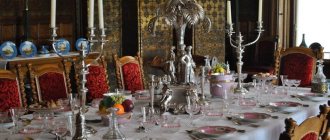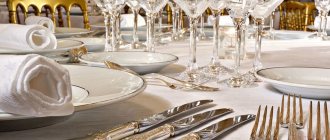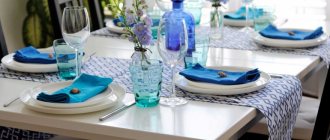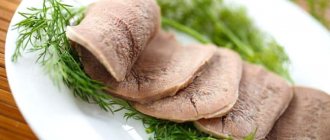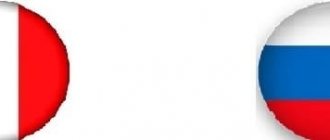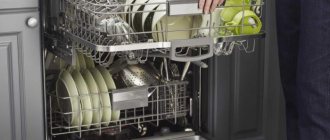It’s so nice to bring family and friends together at the table, and you want the set table to look festive. Some housewives find it difficult to cope with this task. Questions arise about how to arrange the plates correctly, on which side the fork and spoon are placed. You just need to remember how to arrange your cutlery correctly.
Table setting - what you need to know.
Traditional cutlery
Traditional cutlery includes forks, spoons and knives. These are used to create sets whose names speak for themselves:
- snack bar - for salads, appetizers, as well as hot meat dishes;
- fish;
- dining room - in addition to a fork and knife, it includes a soup spoon;
- dessert.
The table set surpasses all others in size. A fish pair is a 3, 4 or 5-pronged fork, sometimes with a hole in the center for removing the bone, and a spatula-shaped knife. For steaks, use a special serrated or sharp knife.
It is no coincidence that the list does not include devices that are intended for laying out food from a common table: tongs, spatulas, ladles. All of them are classified as serving dishes. It is necessary to strictly distinguish between two concepts: serving utensils are common, tableware is individual.
Additional items
What should a housewife have so that her techniques always look convincing and do not contradict etiquette? If tradition is important to you, you need to learn to conform. For example, a special knife for butter is not just a knife from a standard cutlery set, it is different. And if a guest cuts a slice of butter and transfers it to the pie shop, he should be able to do this with a special knife. And there is also, for example, a knife and fork - they use it to cut and transfer cheese (hard).
Imagine, but there is also a special fork for sprat: fish forks differ not only from other forks, but also from each other. A tridentated rounded fork is used for mussels and clams, and it is also used when carrying out cold sea cocktails. Hot fish snacks are consumed with a chill fork.
Minimum set of additional devices:
- pasta tongs - this will allow you to serve pasta in a beautiful common dish, with tongs it is perfectly distributed in portions, and everything looks aesthetically pleasing;
- salad tongs are an alternative to special spoons; both may be present on the table;
- forks and knives for meat (for steak) - appropriate in size, beautiful, durable, with a perfect metallic shine (or, conversely, aristocratically dull, if the color and texture suggest);
- dessert - for cake and for ice cream, completely different products are needed (many different devices have been invented for dessert - for example, not only a spoon is served with tea, but also tongs for sugar cubes);
- snack forks – the guest should not use the same fork to eat appetizers and main courses;
- fruit set - and this characteristic is not sparse, for example, there are even grape scissors that help you carefully cut it from the branch.
If you don't know where to start, start with a dessert set. When you acquire useful devices, invite your friends for tea - it will be akin to a self-test. By the way, make sure you know how to eat cake properly. It should be served to the table already cut into wedges. You need to eat on your own plate, starting with a pointed piece.
Dessert table utensils
The third course is eaten using a triple set. The dessert knife is shaped like a spatula, but smaller than a fish knife. It is held in the left hand to pry small pieces and cut large pieces of fruits and berries. Cakes and pastries are eaten using a snack fork and knife. Select berries from compotes with a dessert spoon.
Dessert table utensils also include spoons for:
- coffee - with a narrow, sometimes oval, handle and a shallow cup-shaped part;
- sugar - popularly called tea.
A coffee spoon and a teaspoon lie on the right side of the saucer with a mug. When stirring drinks, avoid glass clinking.
Subtleties of design for different meals
Depending on the event being served, the following types of table settings are distinguished:
- Banquet room.
- Buffet room.
- Tea room.
- Coffee shop.
- Full evening.
- Dining room, for breakfast or dinner.
Dining
The simplest serving is for lunch, for breakfast or dinner. As a rule, in this case, serving occurs for members of the same family. This could be a Sunday dinner together, or breakfast. It’s good when everyone is accustomed to setting the table every day, adding atmosphere to the meal. This, by the way, promotes family unity and develops certain traditions.
To do this, take plates that match the dish being served. Place a spoon, fork and, if necessary, a knife nearby. If this is a regular meal, then add a glass of juice or water, a cup of tea or coffee with a saucer to the serving. If this is, for example, a Sunday dinner, and you plan to drink alcohol, then also glasses or shot glasses. In this case, the presence of glasses for water should also be taken into account.
Ordinary fabric napkins can serve as table decoration; they can be simply folded in the shape of a rectangle, or laid out in an intricate way. A dish with a variety of fruits or berries can decorate breakfast or dinner. It is always worth considering that a salt and pepper shaker should be served on the table.
Full evening will have some differences. Use only single-colored dishes. Various complex decors are not used - a modest vase (necessarily low and simple in shape) in which there will be a minimum number of flowers on a low stem will be enough. It is better to choose a white tablecloth; as an exception, you can use delicate pastel shades.
Bottles of champagne, wine or other alcohol must be uncorked. You should also place a cloth napkin next to the glasses.
Banquet service
Banquet service is close to full evening service - uniformity should be observed in the dishes, napkins and tablecloths.
To the left of the wine glasses, in the case of a banquet, there is a card with the name of the invitee. Buffet table settings are becoming increasingly popular. There are two types. The first differs in that the table is placed along the wall. It is decorated on one side, that is, guests approach it only from one side. This option is suitable for private parties, hotels and hotels with a buffet. In the second case, the table is placed in such a way that it is accessible from all sides. This type is used for organizing weddings and corporate events.
Coffee serving
Coffee serving depends on what type of coffee will be served - Turkish, in a geyser coffee maker, latte or cappuccino from a coffee maker. In any case, three elements are needed - a coffee cup with a saucer and a coffee spoon. Dessert is served on a common platter, accompanied by dessert plates and cutlery, be it a spoon or a fork with a knife, calculated according to the number of guests.
Decorating with a fruit bowl is appropriate. Serving begins with filling the central part - where berries, fruits and desserts are located. Coffee is prepared and served only after the guests have arrived.
Tea setting - it can be arranged immediately by placing cups on the table if the exact number of guests is known. Everyone needs to be provided with an appropriate saucer for a cup and a dessert plate with a spoon, fork and knife. One or two of these appliances may be removed. So, for example, if dessert should be eaten with a spoon, then you should not serve it with a fork and knife. In the center there is a dish with desserts or a cake bowl with a cake. By the way, a special spatula is used to serve pieces of cake. Also, the serving can be supplemented with a vase or a large dish on which fruits, both sliced and whole, are laid out.
Special cutlery for exotic dishes
At celebrations, hosts and restaurateurs strive to surprise guests with delicious food. Oriental dishes and seafood deserve special attention. For exotic delicacies, etiquette rules provide no less fancy tools:
- Chopsticks - used when serving oriental dishes: sushi, rolls, etc. One chopstick with its thick part is placed in the hollow between the thumb and index finger of the right hand so that the device protrudes a third beyond the palm. Approximately in the middle, the stick should come into contact with the nail phalanx of the ring finger. The second part of the eastern fork is taken like a pencil, held with the thumb, index and middle fingers. How to hold while eating: the upper part is manipulated, while the lower part remains motionless.
- Spoon in the form of a spatula for fish caviar.
- Set for mussels and boiled shrimp. Use tongs to hook the mussel shell with your left hand and hold it over the plate. The meat is eaten with a special fork or a table fork.
- An oyster pair is a knife with a sharp tip used to open the valves and a trident fork for eating the mollusk.
- Set for lobsters: tongs for splitting the shell and a special device - a flat spoon for collecting juice on one side and a fork with two teeth for pulling out meat on the other. The seafood is held with tongs in the left hand, and the right hand alternately uses a double tool.
- Crab set. In restaurants, crabs are cut by cooks or waiters. If the seafood is taken out whole for distribution, then pruning shears are attached to it. The rules for using cutlery for these seafood are as follows. First, cut off the claw and transfer it to a plate. Also, pruners are used to separate the paw at the joints. Each claw is then cut lengthwise. To remove the meat, use lobster tongs, a fork, or a dinner fork.
Seafood can be eaten with your hands if there are no utensils at the table. In this case, rinses are served with acidified water.
Beautiful layout examples
One way or another, there is currently an opinion that only restaurant establishments observe all the subtleties of serving. In fact, this knowledge can be applied to all kinds of family celebrations and other important holidays. There are several common examples:
Serving a romantic dinner for two requires an intimate atmosphere, dim lighting and, of course, the presence of suitable glasses. Additional accessories in the decoration will add a special touch of intimacy. You can start by choosing a color scheme, based on the preferences of your other half, and then you can add significant details: put your favorite flowers, ribbons, memorable souvenirs, a general photo. Music and lit candles of various shapes and sizes will be an integral accompaniment.
An important celebration in a close family circle requires respect for tradition and a classic serving style. The difference between generations is of particular importance, therefore both the style of serving and the overall design of the table should be as generally accepted as possible, not too bright, but solemn in its classics
Restraint combined with solemnity can be expressed in beautifully selected expensive dishes (crystal items are appropriate), cutlery, snow-white napkins and the presence of accents, for example, gold and silver.
Often a ceremonial meal is associated with the celebration of some event. This is where themed table settings come to the rescue. The New Year's or Christmas table is complemented with coniferous products and Christmas tree accessories; sometimes the table setting is decorated with a combination of burgundy, red and green colors.
For the autumn holidays, tables are set with the addition of gems, small seasonal vegetables, acting as accessories. The compositions are complemented with suitable colors.
Summer wedding celebrations will be complemented by light fabrics, delicate pastel colors and thin glassware.
It is very important not to limit your imagination and embody any creative ideas, applying knowledge in table decoration. Any celebration begins with competent table setting, which is sure to make a pleasant impression on all participants in the celebration.
You will learn more about which side of the plate to place the fork and knife according to the rules of etiquette in the following video.
Serving cutlery
Cutlery should be placed on a table covered with a tablecloth, after arranging individual dishes in the following order (starting from the plate):
Right: table knife, then fish knife, tablespoon, snack knife.
Left: dining room, fish, snack fork. To the left of these devices is a pie plate with a butter knife.
On top (12 o'clock from the guest): dessert knife, appetizer fork, dessert spoon. The dessert table can be arranged separately. The plate for third courses occupies a central position near the guest. Since it is correct to hold a fork in the left hand, it is placed on the left, the knife and spoon on the right.
When decorating a table, knives are placed with the blade facing the plate, and forks and spoons with their teeth and bowls facing up. Depending on the time of the celebration (lunch or dinner) and its menu, the serving may vary. Throughout the meal, waiters or hosts make sure that only those utensils that will be useful to guests are on the table.
How to use a knife and fork according to European etiquette
According to the rules of decency and customs of the Old and New Worlds, dinnerware should be held in the same way. The fork is placed on the left hand, the knife is placed on the right. If there is more than one fork, start with the one closest to the plate. The procedure is mostly the same in both types of etiquette, the difference is only in one thing. We usually follow the continental style, which involves using both hands. The fork is taken in the left hand, the knife in the right. Eat with the left hand, do not transfer the device after that to another limb. It is traditionally placed with the cloves facing down.
The fork is placed on the left hand, the knife is placed on the right.
Which devices to take first?
The table is set so that all the utensils are convenient to use. The organizers of the celebration take this into account, and the guests take this into account when choosing tools for food. The location of the cutlery will indicate the correct course of action. It is most convenient to take those objects that do not come into contact with others.
In the “Serving” section, the last items to be placed from the edge of the plate are the fork and knife, because almost all banquets have salads. These devices are the most convenient to take. They will not catch the rest and the risk of dropping anything from the table is reduced to zero. After eating, unnecessary dishes are removed. Throughout the celebration, they take those utensils that are farther from the plate and gradually move on to those that are closer. When it’s time for the third course, only the substitution plate is left, onto which the dessert plate is moved. Instruments are laid out nearby.
How to properly bring a spoon to your mouth
They sit at the table, slightly leaning forward with their whole body. It is forbidden to slouch, lean towards a spoon, or lift a plate. You need to hold the pen between your thumb and index finger and help with the nail phalanx of your middle finger.
For convenience, adhere to the following rules:
- fill the spoon as much as you can eat at one time - no more than 2/3;
- before bringing it to your mouth, hold the spoon against the wall of the plate for a few seconds so that excess drops drain;
- They eat by bringing the device to their lips from a convenient side - the back or side.
These rules allow you to avoid staining yourself and the tablecloth. When scooping the dish into a spoon, guide it with the edge side of the device, without touching the bottom of the plate. They eat silently, without making slurping sounds.
How to properly hold a knife and fork according to etiquette
Meat, poultry, fish, cooked in small pieces, side dishes - these dishes do not require cutting. For them, the table is served only with a fork, on the right side of the plate. The guest takes the device in his right hand. For large-piece and portioned products, place a knife to the right of the plate and a fork to the left. Food is cut with the right hand and eaten with the left.
Also take into account that:
- you need to hold cutlery in your hands, holding it between your index finger, thumb and holding it with your middle finger;
- cut meat and fish, pressing on them lightly so that the piece does not jump out of the plate;
- Until the dish is finished, the cutlery is held in the hands.
Visitors to Russian restaurants have a question in which hand to hold a knife and fork according to etiquette, if both utensils are on the table and there is nothing to cut. In establishments in our country, the table is often set with a full set, even when serving goulash and beef stroganoff. The guest simply has to not use the knife, but take the fork in his right hand.
How to eat pilaf: tips
Many are still figuring out how to eat pilaf correctly. Conservatives believe that pilaf should be eaten with the hands in accordance with tradition. Etiquette lovers claim that pilaf is a rather fatty dish and eating it with your hands is the height of vulgarity.
In the east, it is still customary to eat pilaf with your hands, which requires a lot of skill and skill. There they grab a piece of meat and collect the rice around it with three fingers. You get small balls and place them in your mouth with your hands. In other countries, it is customary to eat pilaf using cutlery.
- Pilaf is a fairly fatty food, so you need to serve unsweetened hot tea to the table, which will melt the fat.
- For pilaf, you need to prepare butter flatbreads, which will also help digest fat faster.
- It is recommended to combine pilaf with some light vegetable salad.
When preparing pilaf, remember that the meat in it should not be too large, because it does not look very nice and is also inconvenient to eat.
How to behave properly after eating?
After finishing the meal, they usually make signs to the waiters:
- When the soup is eaten, the cutlery is placed below. You can't leave them in a deep plate.
- If you like the food, the following gesture is made in the middle of the plate: the fork is positioned with the tines up, the end of the knife points towards it.
- In order for the waiter to take away the food, the fork and knife are folded upside down, parallel to each other, and the plate with them is moved forward a little.
- What to do if the food is not to your taste? It is not necessary to call the staff or ask for a complaint book. You can put the devices in a triangle. The knife should fit between the tines of the fork.
Etiquette prohibits placing crumpled napkins in dishes.
Pre-meal layout
The most difficult and painstaking work is done long before the guests arrive. More precisely, between preparing food and the arrival of guests, you need to set the table. The procedure itself may vary slightly depending on the occasion, the number of guests and the menu. So, to the left of the serving plate you need to place the forks. In a basic setting, everything looks like this:
- The smallest fork should be placed furthest from the plate. Guests will eat her cold appetizers, a variety of salads and fish dishes. This device is used first.
- The next fork is located closer to the same plate. They eat hot appetizers and main courses with it. The size of this fork is larger than the previous one. A distance of 2 cm is maintained from the plate to this fork.
There are only 2 devices at the top of the plate. Moreover, sometimes you can completely forget about such devices, but you still need to know them. Utensils above the serving plate:
- For different sweets, use a dessert spoon.
- The dessert fork is placed next. This device is located closer to the plate. Although this device is not mandatory, it is still present in classic table settings.
Only spoons and knives are placed on the right side of the serving plate. There are absolutely no forks. It looks like this:
- Place a hot knife closest to the guest's plate. The tip is directed towards the plate.
- Next up is a snack knife. The tip is directed there.
- Place the soup spoon furthest from the guest's plate. This element is present on the table only when serving for dinner. Otherwise, this spoon is simply not needed.
Arrangement: how to put a spoon, fork, knife and how to put other things?
The dishes are arranged in the same order in which food is served: soups, fish and meat dishes, desserts. Although it seems that there are too many dishes and cutlery, each element plays its own significant role.
How to properly arrange cutlery, read on:
- A snack plate is placed in front of the seated person. It happens that she stands on a shallow dining room. On the left is a pie plate or napkin. To the right of the snack plate are all the spoons and knives. They are held in the right hand. On the left are forks. They should be in the left hand. Dessert cutlery is located at the front. Which hand you need to hold them with depends on which direction the handles are facing. If to the right, then with the right hand. Left - left.
- Behind them are wine glasses and glasses.
- Place a napkin on the appetizer plate. If there is no first course, then a spoon is not used.
The plates must be located at a distance of at least 60 cm from each other. Their number corresponds to the number of guests. You cannot place more than 3 pairs of devices in front of a person.
Peculiarities
Today, few people pay due attention to studying traditions and customs, so not every housewife can talk about table setting or explain what it is. But it’s worth familiarizing yourself not only with the concept itself, but also with the history of the development of serving
Serving can be presented in several varieties:
Preliminary is the simplest. With such serving, it is enough to partially arrange the dishes and cutlery that will initially be required for the dishes presented first on the menu. When a new dish is served, the dishes will be replaced at the same time.
During pre-serving, it is necessary to use a table knife, fork, teaspoon, pie plate, wine glass, wine glass, decoration items for placing in the center, pepper shaker and salt shaker, as well as a cloth napkin without a print.
- Banquet - consists of simultaneous arrangement of decor, plates and cutlery. To create this type of serving, you will need snack utensils, namely: forks and knives;
- soup spoon;
- fish utensils;
- baking plate;
- bakery plate;
- butter knife;
- dessert spoon;
- pepper shaker;
- soup plate;
- small saucer.
“Bistro” is the usual arrangement of dishes for a casual breakfast or lunch in an informal setting. It can be used in areas where self-service is used. This type of serving is used in establishments where personal staff are served. The choice of cutlery and their location depends on the menu, the cost of the dish and even the style of the establishment. The table should be decorated with a tablecloth, as well as additional napkins.
What not to do in a restaurant?
There are a number of actions, the performance of which indicates a person’s low cultural level. This primarily applies to events and official receptions. Table etiquette rules prohibit:
Call the waiter, addressing him on a first name basis. Talk about politics, religion, health, finances. Communicate loudly, interrupt. Use toothpicks. This must be done exclusively in the bathroom. Pick up food or cutlery that has fallen on the floor. It's worth asking the waiter for a replacement. Use the phone. It's better to turn on silent mode. If the call is extremely important, you can apologize to the interlocutors and warn them. Report diet, alcohol abstinence
There is no need to draw attention to yourself in these matters. Hurry. Even in the event of severe hunger, it is necessary to wait until food is brought to all people. Cut and bite a large piece of bread
Etiquette rules require breaking off small pieces. They are placed into the mouth with their fingers. Place the bag on the table or chair. Restaurants usually have special coasters installed. When they are absent, the bag is hung on the back of the chair, the briefcase is placed on the floor. Pressing tightly against the table or sitting too far away. Only your hands can be placed on the surface.
Video about what not to do at the table:
Arrangement: how to put a spoon, fork, knife and how to put other things?
The dishes are arranged in the same order in which food is served: soups, fish and meat dishes, desserts. Although it seems that there are too many dishes and cutlery, each element plays its own significant role.
How to properly arrange cutlery, read on:
- A snack plate is placed in front of the seated person. It happens that she stands on a shallow dining room. On the left is a pie plate or napkin. To the right of the snack plate are all the spoons and knives. They are held in the right hand. On the left are forks. They should be in the left hand. Dessert cutlery is located at the front. Which hand you need to hold them with depends on which direction the handles are facing. If to the right, then with the right hand. Left - left.
- Behind them are wine glasses and glasses.
- Place a napkin on the appetizer plate. If there is no first course, then a spoon is not used.
The plates must be located at a distance of at least 60 cm from each other. Their number corresponds to the number of guests. You cannot place more than 3 pairs of devices in front of a person.


